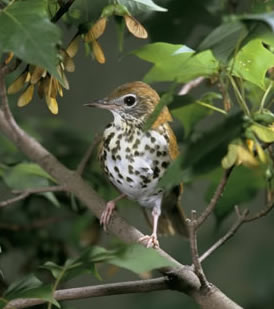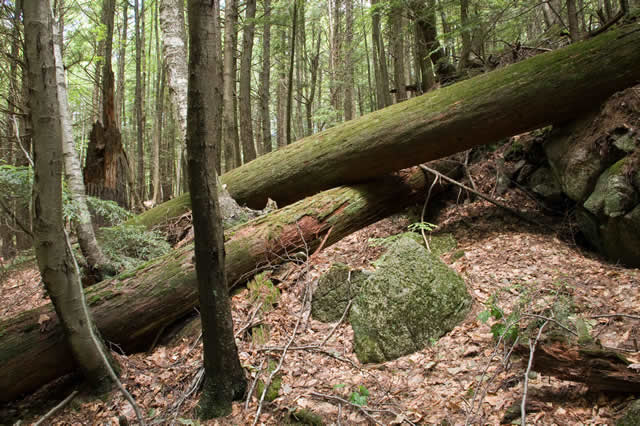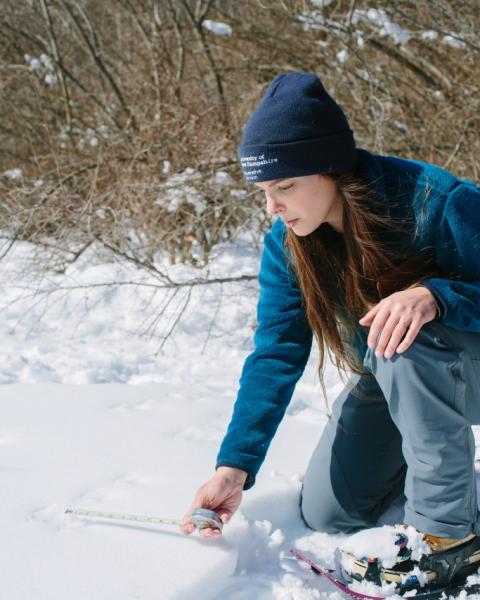Thousands of acres of northern hardwood-conifer forests grow on well-drained, fertile slopes of hillsides in New Hampshire, typically between 1,500 and 2,500 feet in elevation. Here, sugar maple, American beech, and yellow birch are the dominant tree species, mixed with red maple, white ash, and patches of hemlock at lower elevations, and red spruce and balsam fir at higher elevations.
Striped maple, witch hazel and hobblebush shrubs are typical in the understory of northern hardwood-conifer forests, with wild sarsaparilla, starflower, and blue-bead lily on the forest floor. Our vast expanses of northern hardwood-conifer forests in northern and western New Hampshire are famous for both spring wildflower displays and brilliant fall foliage. The best examples of northern hardwood-conifer forests have patches of large trees in the canopy, young trees in the understory, many standing dead trees (snags), and abundant dead and decaying trees on the ground. Large cavity trees, pockets of wetlands, seeps and interspersed patches of conifers make some areas of northern hardwood-conifer forest especially rich for wildlife.
Where are Northern Hardwood-Conifer Forests in New Hampshire?
Northern hardwood-conifer forests cover about 20% of the state, with Grafton and Coos counties containing 80% of that habitat. A band of northern hardwood-conifer forest is also found in the southwestern highlands in Sullivan, Cheshire and parts of Hillsborough Counties. Public lands with extensive examples of northern hardwood-conifer forests include many parts of the White Mountain National Forest, Mountain Pond in Chatham, Cardigan Mountain in Orange, and Fitch Mountain in Stratford. Northern hardwood-conifer forests are shown in the shaded areas of the map at right.
Why are Northern Hardwood-Conifer Forests Important?
Many of New Hampshire’s northern hardwood-conifer forests remain unfragmented by development and roads, making them an important ecological refuge for plants and animals. These forests provide habitat for hundreds of species of wildlife, including forty two mammals and seventy-three birds.
Keeping common wildlife common
Northern hardwood-conifer forests help keep our common wildlife common, providing space for everything from the smallest insects to the widest-ranging mammals and birds. Today, sightings of black bears, scarlet tanagers, pileated woodpeckers, and fisher are com monplace. If they are to remain common, these and other species require a forested backdrop within our rapidly developing landscape.
monplace. If they are to remain common, these and other species require a forested backdrop within our rapidly developing landscape.
Refuge for forest birds
New England forests are home to the highest concentration of breeding songbirds in the United States. Migrating birds such as eastern wood-pewee, black-throated blue warbler, wood thrush (at left) and many others carefully time their arrival to coincide with the swarms of insects (such as black flies and mosquitoes!) that are an important food source for young birds. Maintaining rich and healthy breeding areas for these birds is especially important given extensive habitat loss in the birds’ southern wintering sites in South America, Mexico, and the Caribbean.
Threats to Northern Hardwood-Conifer Forests
Uniformity
Many stands of northern hardwood-conifer forest in New Hampshire are the same age, roughly 80-100 years old. They grew back after extensive timber harvesting and abandonment of farms throughout the last century. Many wildlife species of conservation concern found in northern hardwood-conifer forests are attracted to patches of old or young trees within the larger forest area. Today’s forests don’t support the same high diversity of wildlife species as older forests that contain a diversity of live and dead trees of different ages and sizes. Complicating matters, the public may prefer to view extensive, unbroken mature forest.  As a result, managers are less likely to make large openings (e.g. clearcuts) which will re-grow into the young forests required by many wildlife species.
As a result, managers are less likely to make large openings (e.g. clearcuts) which will re-grow into the young forests required by many wildlife species.
Habitat loss to development
Residential and second-home development in northern hardwood-conifer forests has increased in the last quarter century. The problem is cumulative, as each new development fragments the forest into smaller and smaller blocks, eliminating habitat, separating wildlife populations, inhibiting migration, increasing predation and promoting wildlife collisions on roads.
High-grading
High-grading is a non-sustainable logging practice where the best trees are cut and poor quality trees are left to grow. Some northern hardwood-conifer forests have been repeatedly high-graded, and are now dominated by low-quality, low-value trees and are less dense, less mature, and less diverse. High-grading affects wildlife by removing the larger diameter trees, which reduces the development of large nut-producing trees, large diameter cavity trees, and lessens woody material on the forest floor. Read more about high-grading.
Climate Vulnerabilities of Northern Hardwood-Conifer Forests
- Because these forest types are so widespread, overall impacts from climate change are likely to be highly variable, and often limited by specific site conditions (soil, existing species composition, etc.). In general, northern hardwood species are more likely to shift north or up slope, and be replaced by hemlock-hardwood-pine species. The timing of such shifts will vary considerably among species, and any migration is also likely to take place over timeframes longer than the present assessment considers.
- More frequent disturbance events (e.g., hurricanes, ice storms, tornadoes) will likely favor shade-intolerant, early successional species (paper birch and aspen) over shade tolerant, late successional species (sugar maple and beech). Higher rates of disturbance would also alter the relative proportions of different seral stages of forest.
- Both disturbance and pest/pathogen related mortality could result in larger areas of salvage logging and resulting habitat changes. This could in turn affect nutrient cycling and local hydrology.
- Pressure to develop alternative energy sources (wind turbines) could have significant effects on some areas of northern hardwood-conifer forest. Associated shifts in government policy may open currently protected areas to such development.
Click here for the Northern Hardwood-Conifer Forests Climate Assessment, a section of the Ecosystems and Wildlife Climate Change Adaptation Plan (2013), an Amendment to the NH Wildlife Action Plan
Wildlife Found in Northern Hardwood-Conifer Forests
The wildlife species listed here use northern hardwood-conifer forests. Be on the lookout for these species and follow stewardship guidelines to help maintain or enhance northern hardwood habitats. Species of conservation concern — those wildlife species identified in the Wildlife Action Plan as having the greatest need of conservation — are linked to their species profile from the NH Wildlife Action Plan.
- American woodcock
- Black bear
- Black-throated blue warbler
- Blue-spotted salamander
- Bobcat
- Canada lynx***
- Canada warbler
- Cooper's hawk
- Eastern pipistrelle
- Eastern red bat
- Eastern wood-pewee
- Flying Squirrel
- Gray fox
- Hoary bat
- Mink frog
- Moose
- Northern goshawk
- Northern long-eared bat
- Oven bird
- Purple finch
- Red-eyed vireo
- Ribbon snake
- Ruffed grouse
- Silver-haired bat
- Smooth green snake
- Turkey
- Veery
- White-breasted nuthatch
- White-tailed deer
- Wood thrush
- Wood turtle
*** state endangered, federally threatened species
Stewardship Guidelines for Northern Hardwood-Conifer Forests
- Conserving large blocks (>1000 acres) of northern hardwood-conifer forest from development will provide habitat for wide-ranging wildlife such as black bear, bobcat, Canada lynx and northern goshawk.
- For both land conservation and land stewardship efforts, focus on northern hardwood-conifer habitat characterized by unique features such as:
Large trees (>18” diameter) which are important for roosting bats, goshawk nests, and as future snags (standing dead trees) and den trees for bears, bats, birds, and other species.
- Rocky cliffs which provide sunning areas for bobcat.
- Forested areas near wetlands, streams, ponds, or seeps which provide moist habitat for wood turtle, blue-spotted salamander, ribbon snake, and many songbirds.
- Areas of young, regrowing forest, which provide critical habitat for many wildlife species of conservation concern such as American woodcock, Canada warbler, and bobcat. Patches at least five (5) acres in size will benefit the most wildlife.
- Areas of mature forest with characteristics of old-growth, such as:
- many snags and cavity trees;
- a diversity of tree sizes including both young and old trees growing at all levels of the forest;
- fallen, decaying trees on the forest floor (at right);
- gaps in the canopy where trees have fallen or been cut.
- Pockets of spruce, fir, pine or hemlock trees (conifers), used as winter shelter by northern goshawk, great horned owl, red squirrel, porcupine, and white-tailed deer.
- Using forest management, work to regenerate a mix of tree age classes and tree species. A full range of age classes, well-distributed across the landscape, is important to support the great diversity of wildlife dependent on northern hardwood-conifer habitats. For more information about how forestry can enhance habitat, consult the publication Good Forestry in the Granite State, 2nd edition.
- Provide a supply of patches, over time, of young, regenerating forest
habitat (>2 acres) to enhance cover for wildlife, berry-producing shrubs, hardwood stump sprouts, and other key features of “early successional” habitats (see Shrubland Habitat). The larger the forest opening or clearcut, the greater benefit it has for breeding birds, including those breeding in surrounding forests. To maximize the benefit of new forest openings to wildlife, create new patches, at least 5 acres in size, near utility corridors, shrub wetlands, or brushy old fields.
- Northern hardwood-conifer forests are critical for many migratory forest birds such as blackthroated blue warbler, eastern wood-pewee, and wood thrush. Populations of many forest birds are declining, but most are still common in New Hampshire. An initiative by Vermont Audubon details bird-friendly management practices such as softening edges between habitats and limiting management activities during the breeding season (April-August).
- Wildlife don’t recognize property boundaries. Discuss land stewardship plans with neighboring landowners, and consider cooperating to create on-going, coordinated habitat management projects.
- Always consult a licensed New Hampshire forester before conducting a timber harvest on your property. Understand and follow all laws pertaining to the harvesting of trees near wetlands and waterbodies. Follow established best management practices, and harvest timber near wetlands only when the soils are either frozen (winter) or very dry (summer).
Additional Resources for Northern Hardwood-Conifer Forests
-
Highgrade Harvesting: Understand the Impacts, Know Your Options
- VT Audubon Forest Birds Initiative
- More publications on Habitat Management, and Habitat
- More publications on Woodlot Management
Photo Credits this page: Ben Kimball - NH Natural Heritage Bureau, Emma Carcagno - UNH Cooperative Extension, Mike Marchand - NH Fish & Game, Steve Maslowski - US Fish & Wildlife Service Photo Archives.
Research for this webpage and accompanying Habitat Stewardship brochures was conducted by UNH Cooperative Extension staff with support from the Sustainable Forestry Initiative and NH Fish & Game
